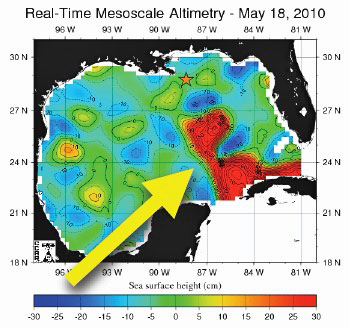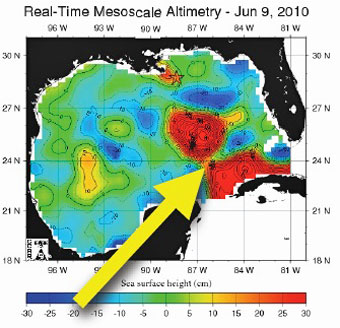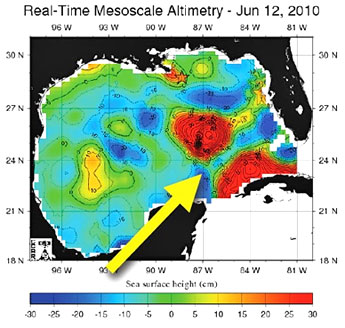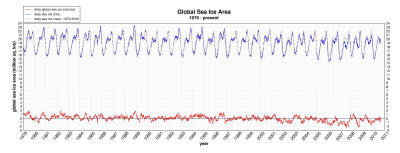|

August 07, 2010
from
PreventDisease Website
Scientists are on high alert following the confirmed shutdown of the
Gulf loop current now correlated to the biochemical and physical
action of the BP oil spill on the Gulf stream.
The shutdown of the current not only
influences the strength of hurricanes but the climate of the entire
planet.
On June 12, 2010, The Institute of Atmospheric Sciences and
Climate (ISAC)
released "Risk of Global Climate Change By BP Oil Spill", a document
detailing how the BP spill may cause irreparable damage to the Gulf
Stream global climate thermoregulation activity.
"The Gulf Stream importance in the
global climate thermoregulation process is well assessed",
states author Gianluigi Zangari.
He adds,
"The latest real time
satellite (Jason, Topex/Poseidon, Geosat Follow-On, ERS-2,
Envisat) data maps of May-June 2010 processed by CCAR 1,2
(Colorado Center for Astrodynamics Research), checked at
Frascati Laboratories by the means of the SHT congruent calculus3
and compared with past years data, show for the first time a
direct evidence of the rapid breaking of the Loop Current, a
warm ocean current, crucial part of the Gulf Stream."
The hollywood blockbuster "The Day After
Tomorrow"
gives a theoretical yet very plausible consequence
of thermo-irregulation in ocean currents and their effect on global
climate.
In fluid dynamics, an eddy is the swirling of a fluid and the
reverse current created when the fluid flows past an obstacle.
The moving fluid creates a space devoid
of downstream-flowing fluid on the downstream side of the object.
Fluid behind the obstacle flows into the void creating a swirl of
fluid on each edge of the obstacle, followed by a short reverse flow
of fluid behind the obstacle flowing upstream, toward the back of
the obstacle.
The release further explained that June
12th marked the point in which the eddy had detached itself
completely from the mainstream therefore destroying the Loop Current
as seen in the figures below.
Real time satellites data maps. Real time sea surface height maps
(below) and sea surface velocity maps starting from april until June
12th processed by CCAR 1,2 and checked at LNF (Frascati)
by SHT calculus.3 The star indicates the site of BP
platform “Deepwater Horizon”.
The yellow arrow indicates the breaking
of the Loop Stream.

 
Radio personality Dr.
Bill Deagle discusses the evidence of a
break in the loop current and potential climate changes with
Dr.
Gianluigi Zangari
"Couple the global temperature
increases with changes in the thermoregulation of the ocean's
currents could spell disaster," stated climatologist Enrico
Lopez.
"It's a little scary because we don't have the data to
interpret this kind of event or forecasts to plot the coming
climate changes," he added.
The world is enduring the hottest year
on record, according to a U.S. national weather analysis, causing
droughts worldwide and a concern for farmers counting on another
bumper year.
Period of a
El Niño weather pattern is being blamed for the hot
temperatures globally, although changes in the ozone, increased
ultraviolet light and increased volcanism are all wild cards in the
same equation.
Abnormally warm temperatures have been registered in large parts of
Canada, Africa, tropical oceans and parts of the Middle East.
Northern Thailand is struggling through the worst drought in 20
years, while Israel is in the middle of the longest and most severe
drought since 1920s. In Britain, this year has been the driest since
1929.
Lopez is concerned about consistent temperature extremes, both hot
and cold in the last few years.
"The thing that most people don't
realize is that cold is becoming a very big problem around the
globe but you rarely hear about it lately outside scientific
circles."
If, as the record shows, the earth has
undergone a series of ice ages every 100,000 years or so like
clockwork, with about 90,000 years of glaciation followed by 10,000
or 12,000 years of interglaciation, and we are now about 12,000
years since the last ice age ended, are we not overdue for another
period of glaciation?
According to Bob Felix, writing in
iceagenow.com:
"Research shows that there was 'a
sudden and dramatic rise' in carbon dioxide in the Earth's
atmosphere at the dinosaur extinction of 65 million years ago...
today's rise in CO2 levels can be attributed to our
warming oceans. After all, the oceans are known as a carbon
dioxide 'sink,' especially when the water is cold."
He adds:
"We've forgotten that this isn't the
first time our seas have warmed. Sea temperatures also shot
upward 10º to 18ºF just prior to the last ice age. As the oceans
warmed, evaporation increased. The excess moisture then fell to
the ground as giant blizzards, giant storms and floods (Noah's
Deluge type floods), and a new ice age began."
And he warns:
"The same thing is happening today.
Underwater volcanic activity in the Arctic Ocean [is] far
stronger than anyone ever imagined!"
According to the
Gosselin blog, never
has ice melted so slowly in mid summer as it has this year.
Indeed
sea ice melt in July 2010 is less than half the melt rate in 2007.
It’s far below anything we’ve seen on
record. And total global sea ice (below image) is actually positive again, despite
the warm global mean temperatures.

The
Neumayer III station, operated by Germany’s
Alfred Wegener
Institute, has
recorded the lowest temperature at their Antarctic
location since the start of operations there 29 years ago. The
mercury dropped to -50.2°C.
Meanwhile Argentina is in an Antarctic cold snap and the
Southern
Hemisphere is freezing. People in Buenos Aires, for instance, are
panic-buying heaters, as the mercury stays between a daytime Celsius
10 and a nighttime one.
Temperatures are also hitting record
lows in Brazil.
Urupema, a town in the southern
Brazilian state of Santa Catarina, is experiencing the lowest
temperature this year - minus 7.8 degrees Celsius. Some 20 towns and
cities of the country are also suffering from unusually cold weather
with temperatures falling below zero.
In New Zealand, the Mercury plunged to record lows this past month.
The National Institute of Water and Atmospheric Research (NIWA)
said the past few days had seen some of the lowest temperatures on
record.
Other "big" changes are also making "big" headlines. NASA-funded
researchers are monitoring a
big event in our planet's atmosphere.
The thermosphere, the layer of rarefied
gases floating high above the Earth has collapsed.
-
Are there forces at work here
that, like cosmic radiation prior to
Robert Millikan's paper
on the phenomenon in 1927?
-
Like Millikan are there
scientists out there who are yet to fully document all the
forces in the universe that have a major effect on the
Earth?
-
And will we discover these
forces in time to prepare, should this cosmic radiation have
a long-term lasting effect on Earth life?
If we factor the destruction of the loop
current in the Gulf into the equation, there will certainly be some
unanticipated changes to global climate.
In the Gulf of Mexico, the deepest areas of warm water are
associated with the Loop Current. The warm waters of the Loop
Current and its associated eddies provide more energy to hurricanes
and allow them to intensify.
The temperature of Gulf waters have also increased 7° higher than
normal.
Multiple reports have concluded the danger of this increase
due to the oil and other chemicals/toxins filling the Gulf will lead
to numerous changes - not the least of which is the expectation that
any storms or hurricanes developing over the region will be stalled
causing them to intensify and slow down causing more destruction as
they linger.
The
Corexit dispersant is also keeping oil submerged at deeper
levels which could be a ticking time bomb when a major hurricane
hits.
The turbulent environment of hurricanes
pulls up water from beneath the surface, often upwelling cooler
water. Stronger hurricanes up-well deeper water. The oil and
dispersant could then contaminate the hurricane spreading the toxins
far inland .
If the water is warm at lower depths, then water being pulled to the
surface remains warm, and the hurricane can increase in intensity if
other atmospheric conditions are also conducive to strengthening. A
continuous supply of warm water is one of several critical factors
in enabling hurricanes to intensify beyond the initial level of a
major hurricane (i.e. Category 3).
Comparative analysis with satellite data did not show significant
anomalies until until May 8th, 2010.
Therefore it may be plausible to
correlate the breaking of the Loop Current with the biochemical and
physical action of the BP Oil Spill on the Gulf Stream. It is
reasonable to foresee the breaking of a crucial warm stream as the
Loop Current as a threat to stability in the thermoregulation of
ocean currents.
It may generate a chain reaction of
unpredictable critical phenomena and instabilities due to strong non linearities which may have serious consequences on the dynamics of
the Gulf Stream and north escalation into Atlantic waters which help
regulate global climate patterns.
Sources
|




